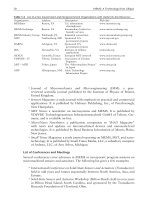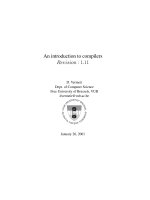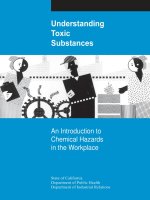An introduction to environmental chemistry
Bạn đang xem bản rút gọn của tài liệu. Xem và tải ngay bản đầy đủ của tài liệu tại đây (5.85 MB, 326 trang )
An Introduction
to Environmental
Chemistry
SECOND EDITION
J.E. Andrews, P. Brimblecombe,
T.D. Jickells, P.S. Liss and B. Reid
School of Environmental Sciences
University of East Anglia
United Kingdom
www.pdfgrip.com
www.pdfgrip.com
An Introduction to
Environmental Chemistry
www.pdfgrip.com
www.pdfgrip.com
An Introduction
to Environmental
Chemistry
SECOND EDITION
J.E. Andrews, P. Brimblecombe,
T.D. Jickells, P.S. Liss and B. Reid
School of Environmental Sciences
University of East Anglia
United Kingdom
www.pdfgrip.com
© 2004 by Blackwell Science Ltd
a Blackwell Publishing company
350 Main Street, Malden, MA 02148-5020, USA
108 Cowley Road, Oxford OX4 1JF, UK
550 Swanston Street, Carlton, Victoria 3053, Australia
The right of J.E. Andrews, P. Brimblecombe, T.D. Jickells, P.S. Liss and B. Reid to be
identified as the Authors of this Work has been asserted in accordance with
the UK Copyright, Designs, and Patents Act 1988.
All rights reserved. No part of this publication may be reproduced, stored in a retrieval
system, or transmitted, in any form or by any means, electronic, mechanical, photocopying,
recording or otherwise, except as permitted by the UK Copyright, Designs, and Patents Act
1988, without the prior permission of the publisher.
First published 1996 by Blackwell Science Ltd
Second edition 2004
Library of Congress Cataloging-in-Publication Data
An introduction to environmental chemistry / J.E. Andrews . . . [et al.]. – 2nd ed.
p. cm.
Includes bibliographical references and index.
ISBN 0-632-05905-2 (pbk.: alk. paper)
1. Environmental geochemistry. I. Andrews, J.E. ( Julian E.)
QE516.4.I57 2004
551.9 – dc21
2003002757
A catalogue record for this title is available from the British Library.
Set in 9–12 /12 pt Janson
by SNP Best-set Typesetter Ltd., Hong Kong
Printed and bound in the United Kingdom
by TJ International, Bodmin, Cornwall
For further information on
Blackwell Publishing, visit our website:
www.pdfgrip.com
Contents
List of boxes ix
Preface to the second edition xi
Preface to the first edition xii
Acknowledgements xiv
Symbols and abbreviations xviii
1 Introduction 1
1.1 What is environmental chemistry? 1
1.2 In the beginning 2
1.3 Origin and evolution of the Earth 2
1.3.1 Formation of the crust and atmosphere 4
1.3.2 The hydrosphere 5
1.3.3 The origin of life and evolution of the atmosphere 8
1.4 Human effects on biogeochemical cycles? 9
1.5 The structure of this book 11
1.6 Internet keywords 12
1.7 Further reading 13
1.8 Internet search keywords 13
2 Environmental chemist’s toolbox 14
2.1 About this chapter 14
2.2 Order in the elements? 14
2.3 Bonding 19
2.3.1 Covalent bonds 19
2.3.2 Ionic bonding, ions and ionic solids 20
www.pdfgrip.com
vi
Contents
2.4
2.5
2.6
2.7
2.8
2.9
2.10
2.11
Using chemical equations 21
Describing amounts of substances: the mole 22
Concentration and activity 22
Organic molecules – structure and chemistry 23
2.7.1 Functional groups 25
2.7.2 Representing organic matter in simple equations 26
Radioactivity of elements 27
Finding more chemical tools in this book 29
Further reading 30
Internet search keywords 30
3 The atmosphere 31
3.1
3.2
3.3
3.4
3.5
3.6
3.7
3.8
3.9
3.10
3.11
3.12
Introduction 31
Composition of the atmosphere 32
Steady state or equilibrium? 35
Natural sources 38
3.4.1 Geochemical sources 39
3.4.2 Biological sources 41
Reactivity of trace substances in the atmosphere 44
The urban atmosphere 45
3.6.1 London smog – primary pollution 46
3.6.2 Los Angeles smog – secondary pollution 48
3.6.3 21st-century particulate pollution 52
Air pollution and health 53
Effects of air pollution 55
Removal processes 56
Chemistry of the stratosphere 58
3.10.1 Stratospheric ozone formation and destruction 59
3.10.2 Ozone destruction by halogenated species 61
3.10.3 Saving the ozone layer 63
Further reading 64
Internet search keywords 65
4 The chemistry of continental solids 66
4.1 The terrestrial environment, crust and material cycling 66
4.2 The structure of silicate minerals 70
4.2.1 Coordination of ions and the radius ratio rule 70
4.2.2 The construction of silicate minerals 73
4.2.3 Structural organization in silicate minerals 73
4.3 Weathering processes 76
4.4 Mechanisms of chemical weathering 77
4.4.1 Dissolution 77
4.4.2 Oxidation 77
4.4.3 Acid hydrolysis 83
4.4.4 Weathering of complex silicate minerals 84
4.5 Clay minerals 87
www.pdfgrip.com
Contents vii
4.6
4.7
4.8
4.9
4.10
4.11
4.12
4.5.1 One to one clay mineral structure 88
4.5.2 Two to one clay mineral structure 88
Formation of soils 93
4.6.1 Parent (bedrock) material (p) 94
4.6.2 Climate (cl) 94
4.6.3 Relief (r) 97
4.6.4 Vegetation (v) 99
4.6.5 Influence of organisms (o) 99
Wider controls on soil and clay mineral formation 104
Ion exchange and soil pH 111
Soil structure and classification 112
4.9.1 Soils with argillic horizons 113
4.9.2 Spodosols (podzols) 113
4.9.3 Soils with gley horizons 117
Contaminated land 119
4.10.1 Organic contaminants in soils 119
4.10.2 Degradation of organic contaminants in soils 125
4.10.3 Remediation of contaminated land 129
4.10.4 Phytoremediation 137
Further reading 139
Internet search keywords 140
5 The chemistry of continental waters 141
5.1 Introduction 141
5.2 Element chemistry 142
5.3 Water chemistry and weathering regimes 145
5.3.1 Alkalinity, dissolved inorganic carbon and pH buffering 151
5.4 Aluminium solubility and acidity 155
5.4.1 Acidification from atmospheric inputs 156
5.4.2 Acid mine drainage 156
5.4.3 Recognizing acidification from sulphate data – ternary diagrams 159
5.5 Biological processes 161
5.5.1 Nutrients and eutrophication 163
5.6 Heavy metal contamination 170
5.6.1 Mercury contamination from gold mining 170
5.7 Contamination of groundwater 174
5.7.1 Anthropogenic contamination of groundwater 176
5.7.2 Natural arsenic contamination of groundwater 178
5.8 Further reading 180
5.9 Internet search keywords 180
6 The oceans 181
6.1 Introduction 181
6.2 Estuarine processes 182
6.2.1 Aggregation of colloidal material in estuaries 183
6.2.2 Mixing processes in estuaries 184
www.pdfgrip.com
viii Contents
6.3
6.4
6.5
6.6
6.7
6.8
6.9
6.10
6.2.3 Halmyrolysis and ion exchange in estuaries 186
6.2.4 Microbiological activity in estuaries 187
Major ion chemistry of seawater 189
Chemical cycling of major ions 191
6.4.1 Sea-to-air fluxes 194
6.4.2 Evaporites 194
6.4.3 Cation exchange 195
6.4.4 Calcium carbonate formation 196
6.4.5 Opaline silica 205
6.4.6 Sulphides 206
6.4.7 Hydrothermal processes 208
6.4.8 The potassium problem: balancing the seawater major ion budget 214
Minor chemical components in seawater 216
6.5.1 Dissolved gases 216
6.5.2 Dissolved ions 216
6.5.3 Conservative behaviour 218
6.5.4 Nutrient-like behaviour 218
6.5.5 Scavenged behaviour 223
The role of iron as a nutrient in the oceans 227
Ocean circulation and its effects on trace element distribution 229
Anthropogenic effects on ocean chemistry 233
6.8.1 Human effects on regional seas 1: the Baltic 233
6.8.2 Human effects on regional seas 2: the Gulf of Mexico 235
6.8.3 Human effects on total ocean minor element budgets? 235
Further reading 237
Internet search keywords 238
7 Global change 239
7.1 Why study global-scale environmental chemistry? 239
7.2 The carbon cycle 240
7.2.1 The atmospheric record 240
7.2.2 Natural and anthropogenic sources and sinks 242
7.2.3 The global budget of natural and anthropogenic carbon dioxide 251
7.2.4 The effects of elevated carbon dioxide levels on global temperature
and other properties 257
7.3 The sulphur cycle 262
7.3.1 The global sulphur cycle and anthropogenic effects 262
7.3.2 The sulphur cycle and atmospheric acidity 265
7.3.3 The sulphur cycle and climate 271
7.4 Persistent organic pollutants 274
7.4.1 Persistent organic pollutant mobility in the atmosphere 274
7.4.2 Global persistent organic pollutant equilibrium 278
7.5 Further reading 281
7.6 Internet search keywords 281
Index 283
Colour plates fall between pp. 138 and 139.
www.pdfgrip.com
Boxes
1.1
Elements, atoms and isotopes 3
3.1
3.2
3.3
3.4
3.5
3.6
3.7
3.8
Partial pressure 34
Chemical equilibrium 37
Acids and bases 40
Gas solubility 43
The pH scale 49
Reactions in photochemical smog 51
Acidification of rain droplets 58
Removal of sulphur dioxide from an air parcel 59
4.1
4.2
4.3
4.4
4.5
4.6
4.7
4.8
4.9
4.10
4.11
4.12
4.13
4.14
Properties of water and hydrogen bonds 69
Electronegativity 74
Oxidation and reduction (redox) 78
Metastability, reaction kinetics, activation energy and catalysts 80
Dissociation 81
Isomorphous substitution 91
Van der Waals’ forces 93
Chemical energy 98
Mineral reaction kinetics and solution saturation 99
Biopolymers 100
Base cations 106
Solubility product, mineral solubility and saturation index 107
Radon gas: a natural environmental hazard 120
Physical and chemical properties that dictate the fate of organic
contaminants 122
www.pdfgrip.com
x
Boxes
4.15 Use of clay catalysts in clean up of environmental contamination 126
4.16 Mechanisms of microbial degradation and transformation of
organic contaminants 128
5.1
5.2
5.3
5.4
5.5
Ionic strength 150
Measuring alkalinity 150
Worked examples of pH buffering 154
Eh-pH diagrams 164
Essential and non-essential elements 171
6.1
6.2
6.3
6.4
6.5
6.6
Salinity 185
Salinity and major ion chemistry of seawater on geological
timescales 190
Residence times of major ions in seawater 192
Ion interactions, ion pairing, ligands and chelation 198
Abiological precipitation of calcium carbonate 202
Oceanic primary productivity 220
7.1
7.2
7.3
Simple box model for ocean carbon dioxide uptake 248
The delta notation for expressing stable isotope ratio values 269
Chiral compounds 279
www.pdfgrip.com
Preface to the
Second Edition
In revision of this book we have tried to respond to constructive criticism from
reviewers and students who have used the book and at the same time have pruned
and grafted various sections where our own experience as teachers has prompted
change. Not least, of course, science has moved on in the eight years since we
prepared the first edition, so we have had to make some substantial changes to
keep up with these developments, especially in the area of global change.
We have tried to retain the ethos of the first edition, using concise and clear
examples of processes that emphasize the chemistry involved. We have also tried
to highlight how the chemistry, processes or compounds interlink between the
chapters and sections, so that no compartment of environmental science is viewed
in isolation.
The substantial changes include more emphasis on organic chemistry, soils,
contaminants in continental water and remediation of contaminated land. To do
this effectively, the terrestrial environments chapter from the first edition has
been split into two chapters dealing broadly with solids and water. We have reorganized the box structure of the book and have placed some of the original box
material, augmented by new sections, to form a new chapter outlining some of
the basic chemical principles that underpin most sections of the book.
Much of the new material has been prepared by Brian Reid, who, in 1999,
joined us in the School of Environmental Sciences at the University of East
Anglia. Brian has very much strengthened the organic chemistry dimension of
the book and we are very pleased to welcome him to the team of authors.
Julian Andrews, Peter Brimblecombe, Tim Jickells, Peter Liss and Brian Reid
University of East Anglia, Norwich, UK
www.pdfgrip.com
Preface to the
First Edition
During the 1980s and 1990s environmental issues have attracted a great deal of
scientific, political and media attention. Global and regional-scale issues have
received much attention, for example, carbon dioxide (CO2) emissions linked with
global warming, and the depletion of stratospheric ozone by chlorofluorocarbons
(CFCs). Local issues, however, have been treated no less seriously, because their
effects are more obvious and immediate. The contamination of water supplies by
landfill leachate and the build up of radon gas in domestic dwellings are no longer
the property of a few idiosyncratic specialists but the concern of a wide spectrum
of the population. It is noteworthy that many of these issues involve understanding chemical reactions and this makes environmental chemistry a particularly important and topical discipline.
We decided the time was right for a new elementary text on environmental
chemistry, mainly for students and other readers with little or no previous chemical background. Our aim has been to introduce some of the fundamental chemical principles which are used in studies of environmental chemistry and to
illustrate how these apply in various cases, ranging from the global to the local
scale. We see no clear boundary between the environmental chemistry of human
issues (CO2 emissions, CFCs, etc.) and the environmental geochemistry of the
Earth. A strong theme of this book is the importance of understanding how
natural geochemical processes operate and have operated over a variety of
timescales. Such an understanding provides baseline information against which
the effects of human perturbations of chemical processes can be quantified. We
have not attempted to be exhaustive in our coverage but have chosen themes
which highlight underlying chemical principles.
We have some experience of teaching environmental chemistry to both
chemists and non-chemists through our first-year course in Environmental
www.pdfgrip.com
Preface to the First Edition xiii
Chemistry, part of our undergraduate degree in Environmental Sciences at the
University of East Anglia. For 14 years we used the text by R.W. Raiswell, P.
Brimblecombe, D.L. Dent and P.S. Liss, Environmental Chemistry, an earlier University of East Anglia collaborative effort published by Edward Arnold in 1980.
The book has served well but is now dated, in part because of the many recent
exciting discoveries in environmental chemistry and also partly because the
emphasis of the subject has swung toward human concerns and timescales. We
have, however, styled parts of the new book on its ‘older cousin’, particularly
where the previous book worked well for our students.
In places the coverage of the present book goes beyond our first-year course
and leads on towards honours-year courses. We hope that the material covered
will be suitable for other introductory university and college courses in environmental science, earth sciences and geography. It may also be suitable for some
courses in life and chemical sciences.
Julian Andrews, Peter Brimblecombe, Tim Jickells and Peter Liss
University of East Anglia, Norwich, UK
www.pdfgrip.com
Acknowledgements
We would like to thank the following friends and colleagues who have helped
us with various aspects of the preparation of this book: Tim Atkinson, Rachel
Cave, Tony Greenaway, Robin Haynes, Kevin Hiscock, Alan Kendall, Gill Malin,
John McArthur, Rachel Mills, Willard Pinnock, Annika Swindell and Elvin
Thurston. Special thanks are due to Nicola McArdle for permission to use some
of her sulphur isotope data.
We have used data or modified tables and figures from various sources, which
are quoted in the captions. We thank the various authors and publishers for permission to use this material, which has come from the following sources.
Books
Andres, R.J., Marland, G., Boden, T. & Bischof, S.
(2000) In The Carbon Cycle, ed. by Schimel, D.S. &
Wigley, T.M.L., pp. 53–62. Cambridge University
Press, Cambridge.
Baker, E.T., German, C.R. & Elderfield, H. (1995)
In Seafloor Hydrothermal Systems: Physical, Chemical,
Biological and Geological Interactions, ed. by
Humphris, S.E., Zierenberg, R.A., Mullineaux,
L.S. & Thomson, R.E., pp. 47–71. Geophysical
Monograph 91. American Geophysical Union,
Washington, DC.
Baird, C. (1995) Environmental Chemistry, W.H.
Freeman, New York.
Berner, K.B. & Berner, R.A. (1987) The Global Water
Cycle. Prentice Hall, Englewood Cliffs, New Jersey.
Berner, R.A. (1980) Early Diagenesis. Princeton
University Press, Princeton.
Birkeland, P.W. (1974) Pedology, Weathering, and
Geomorphological Research. Oxford University Press,
New York.
Brady, N.C. & Weil, R.R. (2002) The Nature and
Properties of Soils, 13th edn. Prentice Hall, New
Jersey.
Brimblecombe, P. (1986) Air Composition and Chemistry. Cambridge University Press, Cambridge.
Brimblecombe, P., Hammer, C., Rodhe, H.,
Ryaboshapko, A. & Boutron, C.F. (1989) In
Evolution of the Global Biogeochemical Sulphur Cycle,
ed. by Brimblecombe, P. & Lein, A. Yu, pp. 77–121,
Wiley, Chichester.
Broecker, W.S. & Peng, T-H. (1982) Tracers in the Sea.
Eldigio Press, New York.
www.pdfgrip.com
Acknowledgements xv
Burton, J.D. & Liss, P.S. (1976) Estuarine Chemistry.
Academic Press, London.
Chester, R. (2000) Marine Geochemistry, 2nd edn.
Blackwell Science, Oxford.
Crawford, N.C. (1984) In Sinkholes: Their Geology,
Engineering and Environmental Impact, ed. by Beck,
B.F., pp. 297–304, Balkema, Rotterdam.
Davies, T.A. & Gorsline, D.S. (1976) In Chemical
Oceanography, vol. 5, ed. by Riley, J.P & Chester, R.,
pp. 1–80, Academic Press, London.
Department of the Environment National Water
Council (1984) Standing Technical Advisory Committee on Water Quality, Fourth Biennial Report, February
1981-March 1983, Standing Technical Committee
Report No. 37. HMSO, London.
Drever, J.I., Li, Y-H. & Maynard, J.B. (1988) In
Chemical Cycles and the Evolution of the Earth, ed.
by Gregor, C.B., Gregor, C.B., Garrels, R.M.,
Mackenzie, F.T. & Maynard, J.B., pp. 17–53, Wiley,
New York.
Garrels, R.M. & Christ, C.L. (1965) Solutions,
Minerals and Equilibria, Harper and Rowe, New
York.
Garrels, R.M., Mackenzie, F.T. & Hunt, C. (1975)
Chemical Cycles and the Global Environment.
Kaufmann, Los Altos.
Gill, R. (1996) Chemical Fundamentals of Geology, 2nd
edn. Chapman & Hall, London.
Houghton, R.A. (2000) In The Carbon Cycle, ed. by
Wigley, T.M.L. & Schimel, D.S., pp. 63–76.
Cambridge University Press, Cambridge.
IPCC (1990) Climate Change: The IPCC Scientific
Assessment, ed. by Houghton, J.T., Jenkins, G.J.
& Ephramus, J.J. Cambridge University Press,
Cambridge.
IPCC (1995) Climate Change 1994. Reports of Working
Groups I and III Intergovernmental Panel on Climate
Change (IPCC). Cambridge University Press,
Cambridge.
IPCC (2001) Climate Change 2001: The Scientific Basis.
Contribution of Working Group I to the Third Assessment Report, Intergovernmental Panel on Climate
Change. Cambridge University Press, Cambridge.
Killops, S.D. & Killops, V.J. (1993) An Introduction to
Organic Geochemistry. Longman Scientific and
Technical, Harlow, Essex.
Koblentz-Mishke, O.J., Volkovinsky, V.V. &
Kabanova, J.G. (1970) In Scientific Exploration of the
South Pacific, ed. by Wooster, W.S., pp. 183–193,
National Academy of Sciences, Washington, DC.
Krauskopf, K.B. & Bird D.K. (1995) Introduction to
Geochemistry, 3rd edn. McGraw-Hill, New York.
Lister, C.R.B. (1982) In The Dynamic Environment of
the Ocean Floor, ed. by Fanning, K.A. & Manheim,
F.T., pp. 441–470. D.C. Heath, Lexington,
Massachusetts.
Marland, G., Boden, T. & Andres, R.J. (2002) Global,
regional and national CO2 emissions. In Trends: A
Compendium of Data on Global Change. Carbon
Dioxide Information Analysis Center, Oak Ridge
National Laboratory, US Department of Energy,
Oak Ridge Tennessee.
McKie, D. & McKie, C. (1974) Crystalline Solids.
Nelson, London.
Moss, B. (1988) Ecology of Freshwaters. Blackwell
Scientific Publications, Oxford.
Polynov, B.B. (1937) The Cycle of Weathering. Murby,
London.
Raiswell, R.W., Brimblecombe, P, Dent, D.L. &
Liss, P.S. (1980) Environmental Chemistry. Edward
Arnold, London.
Schaug, J. et al. (1987) Co-operative Programme for Monitoring and Evaluation of the Long Range Transport of
Air Pollutants in Europe (EMEP). Summary Report
of the Norwegian Institute for Air Research, Oslo.
Scoffin, T.P. (1987) An Introduction to Carbonate Sediments and Rocks. Blackie, Glasgow.
Sherman, G.D. (1952) In Problems in Clay and
Laterite Genesis, p. 154. American Institute of
Mining, Metallurgical, Petroleum Engineers, New
York.
Spedding, D.J. (1974) Air Pollution. Oxford University
Press, Oxford.
Spiedel, D.H. & Agnew, A.F. (1982) The Natural
Geochemistry of our Environment. Perseus Books,
New York.
Strakhov, N.M. (1967) Principles of Lithogenesis, vol. 1.
Oliver & Boyd, London.
Svedrup, H., Johnson, M.W. & Fleming, R.H. (1941)
The Oceans. Prentice Hall, Englewood Cliffs, New
Jersey.
Taylor, R.S. & McLennan, S.M. (1985) The Continental Crust: Its Composition and Evolution. Blackwell
Scientific Publications, Oxford.
Todd, D.K. (1980) Groundwater Hydrology, 2nd edn.
John Wiley, New York.
Von Damm, K.L. (1995) In Seafloor Hydrothermal
Systems: Physical, Chemical, Biological and Geological
Interactions, ed. by Humphris, S.E., Zierenberg,
R.A., Mullineaux, L.S. & Thomson, R.E., pp.
222–247, Geophysical Monograph 91. American
Geophysical Union, Washington, DC.
Wood, L. (1982) The Restoration of the Tidal Thames.
Adam Hilger, Bristol.
www.pdfgrip.com
xvi
Acknowledgements
Articles
Boyd, P.W. and 34 others (2000) Nature 407, 695–702,
Macmillan, London.
Boyle, E.A., Collier, R., Dengler, A.T., Edmond, J.M.,
Ng, A.C. & Stallard, R.R. (1974) Geochimica Cosmochimica Acta 38, 1719–1728, Pergamon, Oxford.
Bruland, K.W. (1980) Earth and Planetary Science
Letters 47, 176–198, Elsevier, Amsterdam.
Buddemeier, R.W., Gattuso, J-P. & Kleypas, J.A.
(1998) LOICZ Newsletter No 4.
Coffey, M., Dehairs, F., Collette, O., Luther, G.,
Church, T. & Jickells, T. (1997) Estuarine Coastal
Shelf Science 45, 113–121, Academic Press, London.
Crane, A. & Liss, P.S. (1985) New Scientist 108 (1483),
50–54, IPC Magazines, London.
Duce, R.A. et al. (1991) Global Biogeochemical Cycles 5,
193–259, American Geophysical Union, Washington, DC.
Edwards, A. (1973) Journal of Hydrology 18, 219–242,
Elsevier, Amsterdam.
Elderfield, H. & Schultz, A. (1996) Annual Review of
Earth and Planetary Sciences 24, 191–224, Annual
Reviews Inc., Palo Alto, California.
Fell, N. & Liss, P.S. (1993) New Scientist 139 (1887),
34–38, IPC Magazines, London.
Fichez, R., Jickells, T.D. & Edmonds, H.M. (1992)
Estuarine Coastal Shelf Science 35, 577–592, Academic Press, London.
Fonselius, S. (1981) Marine Pollution Bulletin, 12,
187–194, Pergamon, Oxford.
Galloway, J.N., Schofield, C.L., Peters, N.E.,
Hendrey, G.R. & Altwicker, E.R. (1983) Canadian
Journal of Fisheries and Aquatic Science 40, 799–806,
NRC Research Press, Ottawa.
Gibbs, R.J. (1970) Science 170, 1088–1090, American
Association for the Advancement of Science,
Washington DC.
Gieskes, J.M. & Lawrence, J.R. (1981) Geochimica Cosmochimica Acta 45, 1687–1703, Pergamon, Oxford.
Heany, S.I., Smyly, W.J. & Talling, J.F. (1986)
Internationale Revue der Gestanten Hydrobiologie 71,
441–494, Wiley–VCH Verlag, Berlin.
Herlihy, A.T., Kaufmann, P.R., Mitch, M.E. & Brown,
D.G. (1990) Water, Air and Soil Pollution 50, 91–107,
Kluwer, Amsterdam.
Husar, R.B., Prospero, J.M. & Stowe, L.C. (1997)
Journal of Geophysical Research, D 102, 16889–16909,
American Geophysical Union.
Kado, D., Baross, J. & Alt, J. (1995) In Seafloor
Hydrothermal Systems: Physical, Chemical, Biological
and Geological Interactions, ed. by Humphris, S.E.,
Zierenberg, R.A., Mullineaux, L.S. & Thomson,
R.E., pp. 446–466, Geophysical Monograph 91.
American Geophysical Union, Washington, DC.
Kimmel, G.E. & Braids, O.C. (1980) US Geological
Survey Professional Paper 1085, 38 pp. US Government Printing Office, Washington, DC.
Legrand, M., Feniet-Saigne, C., Saltzman, E.S.,
Germain, C., Barkov., N.I. & Petrov, N. (1991)
Nature, 350, 144–146, Macmillan, London.
Likens, G., Wright, R.F., Galloway, J.N. & Butler, T.J.
(1979) Scientific American 241(4), 39–17, Scientific
American Inc., New York.
Livingstone, D.A. (1963) Chemical composition of
rivers and lakes. US Geological Survey Professional
Paper.
US
Government
Printing
Office,
Washington, DC.
Macintyre, I.G. & Reid, R.P. (1992) Journal of Sedimentary Petrology 62, 1095–1097, Society for
Sedimentary Geology, Tulsa.
Manabe, S. & Wetherald, R.T. (1980) Journal of the
Atmospheric Sciences 37, 99–118, American Meteorological Society, Boston.
Martin, J.H., Gordon, R.M., Fitzwater, S. &
Broenkow, W.H. (1989) Deep Sea Research, 36,
649–680, Pergamon, Oxford.
Martin, J.-M. & Whitfield, M. (1983) In Trace Metals
in Sea Water, ed. by Wong C.S., Boyle, E., Bruland,
K.W., Burton, J.D. & Goldberg, E.D., Plenum
Press, New York.
Martin, R.T., Bailey, S.W., Eberl, D.D. et al. (1991)
Clays and Clay Minerals 39, 333–335, Clay Minerals
Society, Bloomington.
Maynard, J.B., Ritger, S.D. & Sutton, S.J. (1991)
Geology 19, 265–268, Geological Society of America,
Boulder.
Meybeck, M. (1979) Revue de Geologie Dynamique et de
Geographie Physique 21(3), 215–246, Masson, Paris.
Michot, L.J. & Pinnavaia, T.J. (1991) Clays and Clay
Minerals 39, 634–641, Clay Minerals Society,
Bloomington.
Millero, F.J. & Pierrot, D. (1998) Aquatic Geochemistry
4, 153–199, Kluwer, Amsterdam.
Milliman, J.D. & Meade, R.H. (1983) Journal of
Geology, 91, 1–21, University of Chicago Press,
Chicago.
Nehring, D. (1981) Marine Pollution Bulletin 12,
194–198, Pergamon, Oxford.
Nesbitt, H.W. & Young, G.M. (1982) Nature 299,
715–717, Macmillan, London.
Nesbitt, H.W. &Young, G.M. (1984) Geochimica Cosmochimica Acta 48, 1523–1534, Pergamon, Oxford.
www.pdfgrip.com
Acknowledgements xvii
Orians, K.J. & Bruland, K.W. (1986) Earth Planetary
Science Letters 78, 397–410, Elsevier, Amsterdam.
Petit, J.R. and 18 others (1999) Nature 399, 429–436,
Macmillan, London.
Savoie, D.L. et al. (1993) Journal of Atmospheric Chemistry 17, 95–122. Kluwer, Amsterdam.
Shen, G.T. & Boyle, E.A. (1987) Earth Planetary
Science Letters 82, 289–304, Elsevier, Amsterdam.
Sohrin, Y., Isshiki, K. & Kuwamoto, T. (1987) Marine
Chemistry 22, 95–103, Elsevier, Amsterdam.
Spilhaus, A.F. (1942) Geographical Review 32, 431–435,
American Geographical Society, New York.
Stallard, R.F. & Edmond J.M. (1983) Journal of
Geophysical Research 88, 9671–9688, American
Geophysical Union, Washington, DC.
Stommel, H. (1958) Deep Sea Research 5, 80–82,
Pergamon, London.
United States Environmental Protection Agency.
Superfund Innovative Technology Evaluation
(SITE). EPA/540/S5-91/009. Pilot-scale demonstrationof a slurry-phase biological reactor for
creosote-contaminated soil. Project Summary.
United States Environmental Protection Agency,
Cincinnati.
Watson, A.J., Bakker, D.C.E., Ridgwell, A.J., Boyd,
P.W. & Law, C.S. (2000) Nature, 407, 730–733,
Macmillan, London.
Wedepohl, K.H. (1995) Geochimica Cosmochimica Acta
59, 1217–1232, Pergamon, Oxford.
Woof, C. & Jackson, E. (1988) Field Studies 7,
159–187, Field Studies Council, Shrewsbury.
www.pdfgrip.com
Symbols and
Abbreviations
Multiples and submultiples
Symbol
T
G
M
k
d
c
m
m
n
p
Name
tera
giga
mega
kilo
deci
centi
milli
micro
nano
pico
Equivalent
1012
109
106
103
10-1
10-2
10-3
10-6
10-9
10-12
Chemical symbols
Symbol
a
c
eq
I
IAP
K
K´
Ka
Description
activity
concentration
equivalents
ionic strength
ion activity product
equilibrium constant
first dissociation constant
equilibrium constant for acid
www.pdfgrip.com
Units
mol l-1
mol l-1
eq l-1
mol l-1
moln l-n
moln l-n
moln l-n
moln l-n
Symbols and Abbreviations
Kb
KH
Ksp
Kw
mol
p
equilibrium constant for base
Henry’s law constant
solubility product
equilibrium constant for water
mole (amount of substance – see Section 2.5)
partial pressure
General symbols and abbreviations
Symbol
A
(aq)
atm
ATP
B[a]P
°C
CCD
CCN
CDT
CEC
CFC
CIA
D
DDT
DIC
DIP
DMS
DMSP
DNA
DSi
E°
eEh
EPA
F
FACE
FAO
Fs
G
g
(g)
GEOSECS
GtC
H
H
Description
total amount of gas in atmosphere
aqueous species
atmosphere (pressure)
adenosine triphosphate
benzo[a]pyrene
degrees Celsius (temperature)
calcite compensation depth
cloud condensation nuclei
Canyon Diablo troilite
cation exchange capacity
chlorofluorocarbon
chemical index of alteration
deuterium
2,2-bis-(p-chlorophenyl)-1,1,1-trichloroethane
dissolved inorganic carbon
dissolved inorganic phosphorus
dimethyl sulphide
beta-dimethylsulphoniopropionate
deoxyribonucleic acid
dissolved silicon
standard electrode potential (V)
electron
redox potential (V)
Environmental Protection Agency
flux
free-air CO2 enrichment
Food and Agriculture Organization
furans
Gibbs free energy (kJ mol-1)
gram (weight)
gas
US geochemical ocean sections programme
gigatonnes expressed as carbon
scale height
enthalpy (J mol-1)
www.pdfgrip.com
xix
moln l-n
mol l-1 atm
moln l-n
mol2 l-2
atm
xx
Symbols and Abbreviations
HCFCs
HCH
hn
IAP
IGBP
IPCC
J
K
l
(l)
ln
log10
m
M
MSA
N
n
NAPL
Pa
PAH
PAN
PCBs
PCDD
PCDF
PCP
PM
POP
ppb
ppm
r
S
s
(s)
SOM
SRB
SVOC
T
TBT
TCA
TDIC
UNESCO
USDA
UV
V
V
hydrochlorofluorocarbons
hexachlorocyclohexane
photon of light
ion activity product
International Geosphere–Biosphere Programme
Intergovernmental Panel on Climate Change
joule (energy, quantity of heat)
kelvin (temperature)
litre (volume)
liquid
natural logarithm
base 10 logarithm
metre (length)
a third body
methanesulphonic acid
neutron number
an integer
non-aqueous phase liquid
pascal (pressure)
polycyclic aromatic hydrocarbon
peroxyacetylnitrate
polychlorinated biphenyls
polychlorinated dibenzo-p-dioxin
polychlorinated dibenzo-p-furan
pentachlorophenol
particulate matter
persistent organic pollutant
parts per 109
parts per million
ionic radius
entropy (J mol-1 K-1)
second (time)
solid
soil organic matter
sulphate reducing bacteria
semi-volatile organic compound
absolute temperature (kelvin)
tributyl tin
tricarboxylic acid
total dissolved inorganic carbon
United Nations Educational, Scientific and Cultural
Organisation
United States Department of Agriculture
ultraviolet (radiation)
volt (electrical potential)
volume
www.pdfgrip.com
Symbols and Abbreviations
W
WHO
wt%
Z
z
|z|
watt (power – J s-1)
World Health Organization
weight per cent
atomic number
charge
charge ignoring sign
Greek symbols
a
g
g
d
dd+
t
W
alpha particle (radiation)
activity coefficient
gamma particle (radiation)
stable isotope notation (Box 7.2)
partial negative charge
partial positive charge
change in sum of residence time
degree of saturation
Constants
F
R
Faraday constant (6.02 ¥ 1023 e-)
gas constant (8.314 J mol-1 K-1)
www.pdfgrip.com
xxi
www.pdfgrip.com









